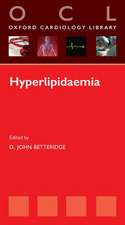Signal Transduction and Cardiac Hypertrophy: Progress in Experimental Cardiology, cartea 7
Editat de Naranjan S. Dhalla, Larry Hryshko, Elissavet Kardami, Pawan K. Singalen Limba Engleză Hardback – 31 ian 2003
| Toate formatele și edițiile | Preț | Express |
|---|---|---|
| Paperback (1) | 1422.50 lei 43-57 zile | |
| Springer Us – 31 oct 2012 | 1422.50 lei 43-57 zile | |
| Hardback (1) | 1427.42 lei 43-57 zile | |
| Springer Us – 31 ian 2003 | 1427.42 lei 43-57 zile |
Preț: 1427.42 lei
Preț vechi: 1502.55 lei
-5% Nou
Puncte Express: 2141
Preț estimativ în valută:
273.13€ • 285.94$ • 226.00£
273.13€ • 285.94$ • 226.00£
Carte tipărită la comandă
Livrare economică 07-21 aprilie
Preluare comenzi: 021 569.72.76
Specificații
ISBN-13: 9781402072185
ISBN-10: 140207218X
Pagini: 508
Ilustrații: XVII, 508 p.
Dimensiuni: 155 x 235 x 30 mm
Greutate: 0.86 kg
Ediția:2003
Editura: Springer Us
Colecția Springer
Seria Progress in Experimental Cardiology
Locul publicării:New York, NY, United States
ISBN-10: 140207218X
Pagini: 508
Ilustrații: XVII, 508 p.
Dimensiuni: 155 x 235 x 30 mm
Greutate: 0.86 kg
Ediția:2003
Editura: Springer Us
Colecția Springer
Seria Progress in Experimental Cardiology
Locul publicării:New York, NY, United States
Public țintă
ResearchCuprins
I. Cardiac Adaptation and Remodeling.- 1. Molecular Changes of the Myocardium after Mechanical Circulatory Support.- 2. Reverse Molecular Remodeling of the Failing Human Heart Following Support with a Left Ventricular Assist Device.- 3. Stretch-Elicited Autocrine/Paracrine Mechanism in the Heart.- 4. L-Arginine at the Crossroads of Biochemical Pathways Involved in Myocardial Hypertrophy.- 5. Signal Transduction System in Human Aortic Smooth Muscle Cell Stimulated by Pure Pressure.- 6. Role of Mitochondrial KATP Channels in Improved Ischemic Tolerance of Chronically Hypoxic Adult and Immature Hearts.- 7. Ca2+–Dependent Signaling Pathways Through Calcineurin and Ca2+/Calmodulin–Dependent Protein Kinase in Development of Cardiac Hypertrophy.- 8. Calreticulin, Cardiac Development and Congenital Complete Heart Block in Children.- 9. Expression of Sodium-Calcium Exchanger Genes in Heart and Skeletal Muscle Development. Evidence for a Role of Adjacent Cells in Regulation of Transcription and Splicing.- 10. Na+/H+ Exchanger and Myocardial Hypertrophy.- II. Cardiac Signal Transduction.- 11. Role of the Electrogenic Na+/HCO3- Symport in the Heart.- 12. Modulation of Atrial Natriuretic Peptide (ANP)-C Receptor and Associated Signaling by Vasoactive Peptides.- 13. RAB3 Small GTP–Binding Proteins: Regulation by Calcium/Calmodulin.- 14. Novel Aspects of Mechanical Signaling in Cardiac Tissue.- 15. Caspase Activation in a Cardiac Cell-Free Model of Apoptosis.- 16. The Role of the Voltage-Sensitive Release Mechanism in Contraction of Normal and Diseased Heart.- 17. Role of AT1 Receptor Blockade in Reperfused Myocardial Infarction.- 18. Relation Between Intracellular Ca2+ Concentration and Contraction in Tetanized Myocyctes of Rat and Mouse.- 19. The Role of Hydrogen Peroxide as aSignaling Molecule.- 20. Localized Control of Oxidative Phosphorylation within Intracellular Energetic Units in Heart Cells: A Possible Solution of Some Old Problems.- 21. Role of High Molecular Weight Calmodulin Binding Protein in Cardiac Muscle.- 22. ?-Adrenergic Signaling in Chronic Heart Failure—Friend or Foe?.- 23. Compartmentation to Lipid Rafts as a Mechanism to Regulate ?-Adrenergic Receptor Signaling in Cardiomyocytes.- 24. Role of Renin-Angiotensin System in Phospholipase C-Mediated Signaling in Congestive Heart Failure.- 25. JAK/Stat Signaling in Cardiac Diseases.- III. Genetic Approaches to Investigative Cardiac Signal Transduction.- 26. Signaling Pathways Involved in the Stimulation of DNA Synthesis by Tumor Necrosis Factor and Lipopolysaccharide in Chick Embryo Cardiomyocytes.- 27. The Application of Genetic Mouse Models to Elucidate a Role for Fibroblast Growth Factor-2 in the Mammalian Cardiovascular System.- 28. Interaction of COUP-TF II With the Rat Carnitine Palmitoyltransferase I B Promoter in Neonatal Rat Cardiac Myocytes.- 29. Altered Expression of Conventional Calpains Influences Apoptosis.- 30. KLF5/BTEB2, a Krüppel-Like Transcription Factor, Regulates Smooth Muscle Phenotypic Modulation.- 31. Transgenic Manipulation of SERCA and PLB Levels and Their Effect on Cardiac Contractility.- 32. Expression of Vascular Endothelial Growth Factor and Hypoxia-Inducible Factor 1? in the Myocardium.- 33. Gene-Based Therapy of Advanced Heart Failure Secondary to the Disruption of Dystrophin-Related Proteom.- 34. Adaptation to Ischemia by In Vivo Exposure to Hyperoxia-Signalling Through Mitogen Activated Protein Kinases and Nuclear Factor Kappa B.- 35. The SERCA2 Gene: Genomic Organization and Promoter Characterization.














